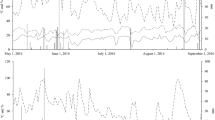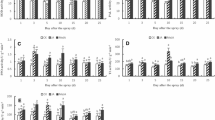Abstract
The phloem-feeding psyllid, Agonoscena pistaciae, is an important key pest of Pistacia vera in several Asian countries. Plant response to this pest is regulated in part by the salicylate and/or jasmonate signaling pathways. Here, the effects of exogenous methyl jasmonate (MeJa) and salicylic acid (SA) application on P. vera leaves were assessed comparing the number of nymphs and eggs per leaflets. Also, the activities of selected antioxidant enzymes, hydrogen peroxide, phenolic content and protein content were evaluated. The effects of MeJa and SA were concentration dependent, with higher concentration of SA failing to induce a more active response. SA was found more efficient than MeJa, as 3 days after hormonal spraying the egg number decreased by 79 and 56 %, after SA and MeJa treatments, respectively, and the nymph density by 73 and 64 %. Both MeJa and SA increased antioxidant enzyme activities, whereas they decreased total protein content. SA affected negatively also the total phenolic content. The levels of hydrogen peroxide were not changed by hormonal treatments.


Similar content being viewed by others
References
Bastam N, Baninasab B, Ghobadi C (2012) Improving salt tolerance by exogenous application of salicylic acid in seedlings of pistachio. Plant Growth Regul. doi:10.1007/s10725-012-9770-7
Bradford MM (1976) Rapid and sensitive method for the quantitation of microgram quantities of protein utilizing the principle of protein–dye binding. Anal Biochem 72:248–254
Chaman ME, Copaja SV, Argandona VH (2003) Relationships between salicylic acid content, phenylalanine ammonia-lyase (PAL) activity, and resistance of barley to aphid infestation. J Agric Food Chem 51:2227–2231
Chen JY, Wen PF, Kong WF, Pan QH, Zhan JC, Li JM, Wan SB, Huang WD (2006) Effect of salicylic acid on phenylpropanoids and phenylalanine ammonia-lyase in harvested grape berries. Postharvest Biol Technol 40:64–72
Dixon RA, Paiva NL (1995) Stress-induced phenylpropanoid metabolism. Plant Cell 7(7):1085–1097
Dulcet-Sanjuan R, Claveria E (1995) Improved shoot-tip micropropagation of Pistacia vera L. and the beneficial effects of methyl jasmonate. J Am Soc Hortic Sci 120:938–942
Ferguson L, Polito V, Kallsen C (2005) The pistachio tree; botany and physiology and factors that affect yield. In: Ferguson L (ed) Pistachio production manual, 4th edn. University of California, Davis, pp 31–39
Julkunen-Titto R (1985) Phenolic constituents in the leaves of northern willows. Methods for analysis of certain phenolics. J Agric Food Chem 33:213–217
Kar M, Mishra D (1976) Catalase, peroxidase, polyphenol oxidase activities during rice senescence. Plant Physiol 57:315–319
Kiriukhin G (1946) Les insects nuisibles au pistacier en Iran. Entomol Phytopathol Appl 1:8–24
Lattanzio V, Lattanzio VMT, Cardinali A (2008) Role of phenolics in the resistance mechanisms of plants against fungal pathogens and insects. Phytochem Adv Res 661:23–67
Li C, Williams MM, Loh Y-T, Lee GI, Howe GA (2002) Resistance of cultivated tomato to cell content-feeding herbivores is regulated by the octadecanoid-signalling pathway. Plant Physiol 130:494–503
Mehrnejad MR (2001) The current status of pistachio pests in Iran. Cah Options Mediterr 56:315–322
Ochoa-Alejo N, Gomez-Peralta JE (1993) Activity of enzymes involved in capsaicin biosynthesis in callus tissue and fruits of chili pepper (Capsicum annuum L.). J Plant Physiol 141:147–152
Pegadaraju V, Knepper C, Reese J, Shah J (2005) Premature leaf senescence modulated by the Arabidopsis PHYTOALEXIN DEFICIENT4 gene is associated with defense against the phloem-feeding green peach aphid. Plant Physiol 139(4):1927–1934
Pieterse CMJ, Van der Does D, Zamioudis C, Leon-Reyes A, Van Wees SCM (2012) Hormonal modulation of plant immunity. Annu Rev Cell Dev Biol 28:489–521
Schenk PM, Kazan K, Wilson I, Anderson JP, Richmond T et al (2000) Coordinated plant defense response in Arabidopsis revealed by microarray analysis. Proc Natl Acad Sci USA 97:11655–11660
Sergiev I, Alexieva V, Karanov E (1997) Effects of spermine, atrazine and combination between them on some endogenous protective systems and stress markers in plants. C R Acad Bulg 51:121–124
Thompson GA, Goggin FL (2006) Transcriptomics and functional genomics of plant defense induction by phloem-feeding insects. J Exp Bot 57:755–766
Tscharntke T, Thiessen S, Dolch R, Boland W (2001) Herbivory, induced resistance and interplant signal transfer in Alnus glutinosa. Biochem Syst Ecol 29:1025–1047
Vasquez-Gomez R, Day R, Buschmann H, Randles S, Beeching JR, Cooper R (2004) Phenyl propanoids, phenylalanine ammonia lyase, and peroxidase in elicitor challenged cassava (Manihotesculenta) suspension cells and leaves. Ann Bot 94:87–97
Vlot AC, Dempsey DA, Klessig DF (2009) Salicylic acid, a multifaced hormone to combat disease. Annu Rev Phytopathol 47:177–206
Wang L, Chen S, Kong W, Li S, Archbold DD (2006) Salicylic acid pretreatment alleviates chilling injury and affects the antioxidant system and heat shock proteins of peaches during cold storage. Postharvest Biol Technol 41:244–251
Zhao J, Davis LC, Verpoorte R (2005) Elicitor signal transduction leading to production of plant secondary metabolites. Biotechnol Adv 23:283–333
Acknowledgments
The authors thank Dr Mohammadi, dean of the Iranian Pistachio Research Institute for providing research orchard.
Author information
Authors and Affiliations
Corresponding author
Additional information
Handling Editor: Jarmo Holopainen.
This work is dedicated to Dr Mohammad Reza Mehrnejad whose his pioneering research inspired several generations of pistachio researchers to pursue the study of pistachio–insect interactions.
Rights and permissions
About this article
Cite this article
Shahabinejad, M., Shojaaddini, M., Maserti, B. et al. Exogenous application of methyl jasmonate and salicylic acid increases antioxidant activity in the leaves of pistachio (Pistacia vera L. cv. Fandoughi) trees and reduces the performance of the phloem-feeding psyllid Agonoscena pistaciae . Arthropod-Plant Interactions 8, 525–530 (2014). https://doi.org/10.1007/s11829-014-9334-z
Received:
Accepted:
Published:
Issue Date:
DOI: https://doi.org/10.1007/s11829-014-9334-z




